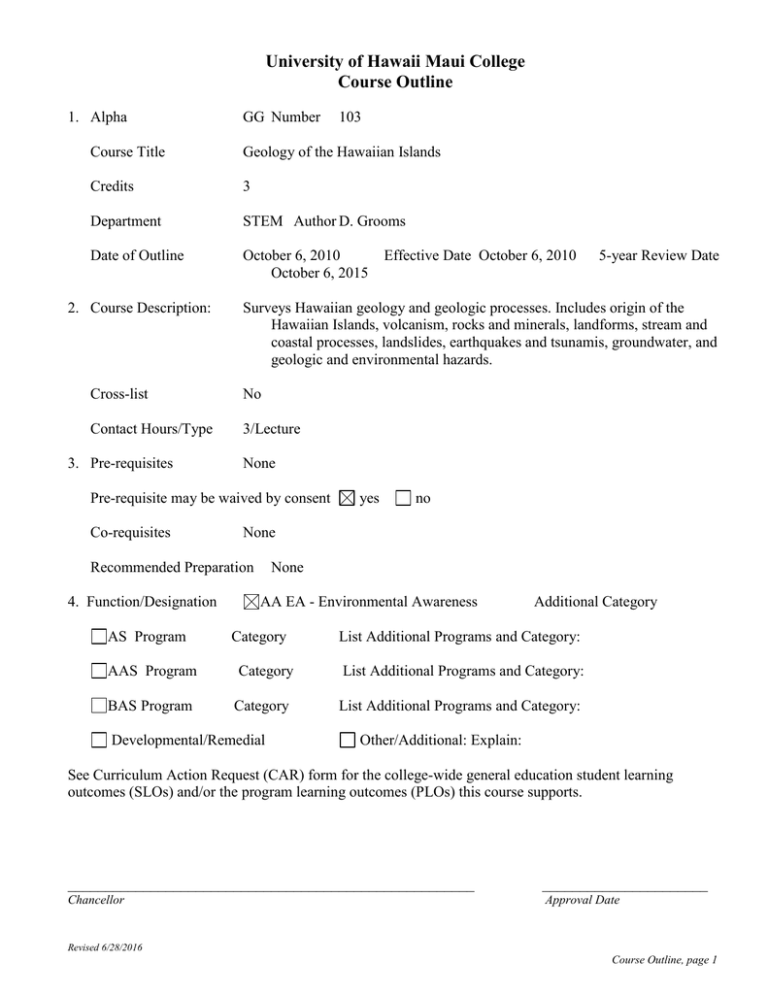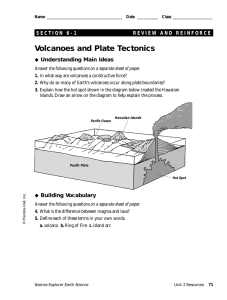F10 Amnesty ,
advertisement

University of Hawaii Maui College Course Outline 1. Alpha GG Number 103 Course Title Geology of the Hawaiian Islands Credits 3 Department STEM Author D. Grooms Date of Outline October 6, 2010 October 6, 2015 2. Course Description: No Contact Hours/Type 3/Lecture None Pre-requisite may be waived by consent Co-requisites AS Program yes no None Recommended Preparation 4. Function/Designation 5-year Review Date Surveys Hawaiian geology and geologic processes. Includes origin of the Hawaiian Islands, volcanism, rocks and minerals, landforms, stream and coastal processes, landslides, earthquakes and tsunamis, groundwater, and geologic and environmental hazards. Cross-list 3. Pre-requisites Effective Date October 6, 2010 None AA EA - Environmental Awareness Category Additional Category List Additional Programs and Category: AAS Program Category List Additional Programs and Category: BAS Program Category List Additional Programs and Category: Developmental/Remedial Other/Additional: Explain: See Curriculum Action Request (CAR) form for the college-wide general education student learning outcomes (SLOs) and/or the program learning outcomes (PLOs) this course supports. ______________________________________________________ ______________________ Chancellor Approval Date Revised 6/28/2016 Course Outline, page 1 2 This course outline is standardized and/or the result of a community college or system-wide agreement. Responsible committee: No 5. Student Learning Outcomes (SLOs): List one to four inclusive SLOs. For assessment, link these to #7 Recommended Course Content, and #9 Recommended Course Requirements & Evaluation. Use roman numerals (I., II., III.) to designate SLOs On successful completion of this course, students will be able to: I. Outline, diagram, and explain the physical nature of the solid earth with special emphasis on the Hawaiian Islands; and, how tectonic forces have shaped the planet over time. II. Clearly explain the rock cycle, and compare and contrast the rocks and minerals it represents. III. Compare and contrast the different types of volcanoes, their eruption styles, and their mineral and rock compositions with special emphasis on the volcanoes of Hawai‘i. IV. Explain the agents of erosion and deposition, resulting depositional environments, and the effects on the environment.. 6. Competencies/Concepts/Issues/Skills For assessment, link these to #7 Recommended Course Content, and #9 Recommended Course Requirements & Evaluation. Use lower case letters (a., b.…zz. )to designate competencies/skills/issues On successful completion of this course, students will be able to: a. describe the general physical physics of planet earth (I) b. discuss the basic atomic structure and mineral formation leading to the formation of liquid magma and igneous rocks (II) c. explain the rock cycle, identify and classify igneous, sedementary, and metamorphic rocks (II, III) d. compare and contrast the classification of volcanic eruptions, and the igneous rocks associated with each type (II, III) e. describe the weathering process and how it relates to the formation of sedimentary rocks and depositional systems (II, IV) f. explain the concept of geologic time, describe basic stratigraphic principles, and clearly explain the major geological processes that led to the formation of the Hawaiian Islands (I-IV) g. explain the causes of earthquakes and tsunamis; and, how to locate an earthquake's epicenter. Explain the hazards of earthquakes and tsunamis to Hawai‘i and assess man's prediction capabilities of these hazards (I, IV) h.diagram the interior structure of the earth and Hawaiian volcanoes (I, III). i. explain the theory of plate tectonics and how it relates to the formation of the earth and the Hawaiian Islands (I, III) j. explain mass movement and describe how the work of water helps shape the landscape of the Hawmaiian Islands (IV) k. define the hydrologic cycle and explain the process of groundwater formation, especially its importance to the peoples of Hawai‘i (III, IV) l. discuss the effects of man's contributions to improving or destroying the varied environments found throughout the Hawaiian Islands (IV). 7. Suggested Course Content and Approximate Time Spent on Each Topic Linked to #5. Student Learning Outcomes and # 6 Competencies/Skills/Issues 1-2 Weeks Revised 6/28/2016 Introduction (I-IV; a-l) Current volcanic activity (I-III; a, c, d, h) course outline 3 1-2 Weeks Plate Tetonics (I, III; a, h, i) Origin of the Hawaiian Islands (I, III; a, h, i) 1-2 Weeks Hawaiian volcanic activity (I-III; a, d, h, i) Types of volcanic eruptions and hazards (I-III; d, g, h, i, l) 1-3 Weeks Hawaiian minerals and igneous rocks (II; b, c, d) 1-3 weeks Sedimentary and metamorphic rocks (II; c, e, f) 1-2 Weeks Life stages of Hawaiian volcanoes (I-III; b-f, h, i) Regional geology and age of the Hawaiian Islands (I-IV; a-l) 1-3 Weeks Rock deformation, earthquakes, and tsunamis (I; g-j) 1-2 Weeks Mass wasting, rock weathering, and soil (II, IV; c, e, j, k) 1-2 Weeks Groundwater and the hydrologic cycle (II, IV; c, e, j, k, l) 1-2 Weeks Work of the ocean, wind, and ice (II, IV; c, e, j, k, l) 0-2 Weeks Special topics (variable) 8. Text and Materials, Reference Materials, and Auxiliary Materials Appropriate text(s) and materials will be chosen at the time the course is offered from those currently available in the field. Examples include: Macdonald et. al. Volcanoes in the Sea, University of Hawaii Press Appropriate reference materials will be chosen at the time the course is offered from those currently available in the field. Examples include: Articles/handouts at the discretion of the instructor. Appropriate auxiliary materials will be chosen at the time the course is offered from those currently available in the field. Examples include: Rock and mineral identification kits, rock and mineral samples, demonstration equipment. 9. Suggested Course Requirements and Evaluation Linked to #5. Student Learning Outcomes (SLOs) and #6 Competencies/Skills/Issues Specific course requirements are at the discretion of the instructor at the time the course is being offered. Suggested requirements might include, but are not limited to: Examinations Quizzes In class exercises Homework Projects/reports/portfolios/field trip notes Attendance Revised 6/28/2016 30-80% 0-20% 0-40% 0-30% 0-30% 0-20% course outline 4 10. Methods of Instruction Instructional methods will vary considerably by instructor. Specific methods are at the discretion of the instructor teaching the course and might include, but are not limited to: In class demonstrations Field demonstrations or identifications Lecture Various forms of technology (online, multi-media), group discussion, guest speakers, student presentations, question and answer, experiments, service learning, reflective journals) 11. Assessment of Intended Student Learning Outcomes Standards Grid attached 12. Additional Information: Assessment of Intended Student Learning Outcomes Standards – CCOWIQs with Ratings for GG 103 Key: 3 = Major Emphasis: The student is actively involved (uses, reinforces, applies, and evaluated) in the student learning outcomes. The learner outcome is the focus of the class. 2 = Moderate Emphasis: The student uses, reinforces, applies and is evaluated by this learner outcome, but it is not the focus of the class 1 = Minor Emphasis: The student is provided an opportunity to use, reinforce, and apply this learner outcome, but does not get evaluated on this learner outcome 0 = No Emphasis: The student does not address this learner outcome Standard 1: Written Communication GG 103 Write effectively to convey ideas that meet the needs of specific audiences and purposes. 1.1 Use writing to discover and articulate ideas 1 1.2 Identify and analyze the audience and purpose for any intended communication 0 1.3 Choose language, style and organization appropriate to particular purposes and audiences 2 1.4 Gather information and document sources appropriately 1 1.5 Express a main idea as a thesis, hypothesis, and other appropriate content 0 1.6 Develop a main idea clearly and concisely with appropriate content 1 1.7 Demonstrate mastery of the conventions of writing, including grammar, spelling, and mechanics 2 1.8 Demonstrate proficiency in revision and editing 0 1.9 Develop a personal voice in written communication 1 Standard 2: Quantitative Reasoning Synthesize and articulate information using appropriate mathematical methods to solve problems and logically address real-life situations. 2.1 Apply numeric, graphic and symbolic skills and other forms of quantitative reasoning, accurately and appropriately 2 2.2 Demonstrate mastery of mathematical concepts, skills, and applications, using technology when appropriate 1 2.3 Communicate clearly and concisely the methods and results of quantitative problem solving 1 2.4 Formulate and test hypotheses using numerical experimentation 0 2.5 Define quantitative issues and problems, gather relevant information, analyze that information, and present results 2 2.6 Assess the validity of statistical conclusions 0 Standard 3: Information Retrieval and Technology (Information Literacy) Access, evaluate, and utilize information effectively, ethically and responsibly. 3.1 Use print and electronic information technology ethically and responsibly 1 3.2 Demonstrate knowledge of basic vocabulary, concepts, and operations of information technology and retrieval 0 3.3 Recognize, identify, and define an information need 1 3.4 Access and retrieve information through print and electronic media, evaluating the accuracy and authenticity of that information 1 Revised 6/28/2016 course outline 5 3.5 Create, manage, organize, and communicate information through electronic media 3.6 Recognize changing technologies and make informed choices about their appropriateness and use. Standard 4: Oral Communication Practice ethical and responsible oral communications appropriate to a variety of audiences and purposes. 4.1 Identify and analyze the audience and purpose of any intended communication. 4.2 Gather, evaluate, select, and organize information for the communication. 4.3 Use language, techniques, and strategies appropriate to the audience and occasion. 4.4 Speak clearly and confidently, using the voice, volume, tone, and articulation appropriate to the audience and occasion 4.5 Summarize, analyze, and evaluate oral communications and ask coherent questions as needed. 4.6 Use competent oral expression to initiate and sustain discussion. Standard 5: Critical Thinking Apply critical reasoning skills to effectively address the challenges and solve problems. 5.1 Identify and state problems, issues, arguments, and questions contained in a body of information. 5.2 Identify and analyze assumptions and underlying points of view relating to an issue or problem. 5.3 Formulate research questions that require descriptive and explanatory analyses. 5.4 Recognize and understand multiple modes of inquiry, including investigative methods based on observation and analysis. 5.5 Evaluate a problem, distinguishing between relevant and irrelevant facts, opinions, assumptions, issues, values, and biases through the use of appropriate evidence. 5.6 Apply problem-solving techniques and skills, including the rules of logic and logical sequence. 5.7 Synthesize inform from various sources, drawing appropriate conclusions. 5.8 Communicate clearly and concisely the methods and results of logical reasoning. 5.9 Reflect upon and evaluate their thought processes, value system, and world views in comparison to those of others. Standard 6: Creativity Able to express originality through a variety of forms. 6.1 Generates responses to problems and challenges through intuition and non-linear thinking. 6.2 Explores diverse approaches to solving a problem or addressing a challenge. 6.3 Sustains engagement in activities without a preconceived purpose. 6.4 Demonstrates the ability to trust and follow one’s instincts in the absence of external direction. 6.5 Applies creative principles to discover and express new ideas. 6.6 Builds upon or adapts the ideas of others to create novel expressions or new solutions. Revised 6/28/2016 course outline 0 0 0 0 1 1 0 1 3 2 2 3 3 3 2 1 1 2 1 0 2 3 0


